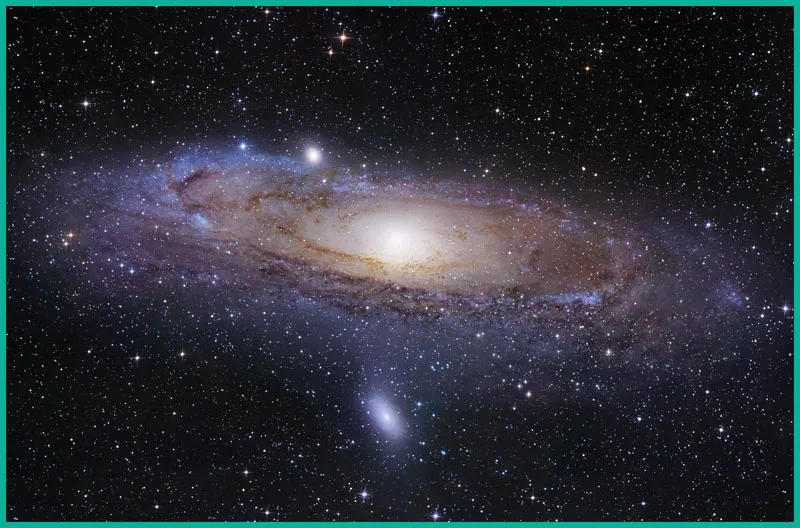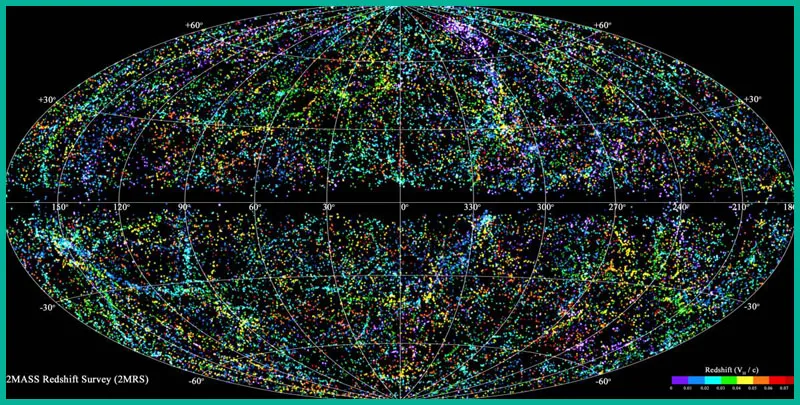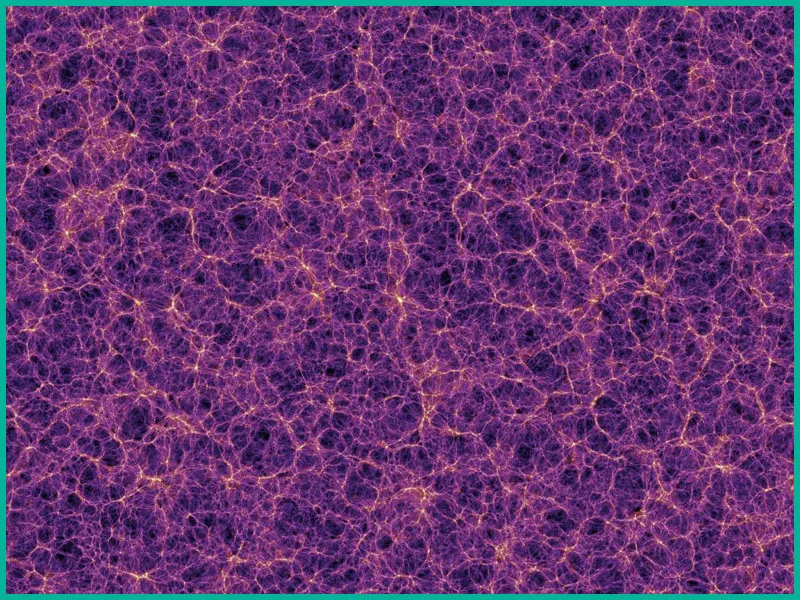Attempts by scientists to squeeze an immense cosmos into a definite form, to limit it to concrete frames seem to the ordinary inhabitants to be completely meaningless. Is it possible for our universe to have any boundaries - it is without end and edge!

Such statements are akin to those great ideas that radically change our view of our place in this world. One such upheaval in consciousness occurred in 1543, when Nikolai Copernicus showed that the Earth is not the center of the universe. In the twenties of the twentieth century, Edwin Hubble, noticing that the galaxies in the universe are moving away from each other, gave life to the idea that our universe did not exist forever, but was formed as a result of a certain event - the Big Bang. Now we are on the verge of a new discovery. If the limits of the universe are found, we will face a new even more difficult question: what is there beyond the borders?
We are guided by the stars
Infinity of the universe implies that it must be infinite not only in space, but also in time, and hence, have an infinite number of stars. In this case, our sky would be entirely dotted with lights and dazzlingly bright around the clock. However, the celestial darkness indicates that the cosmos did not exist forever. According to a common theory, it all started with the Big Bang, which allowed the very existence and expansion of matter. Already the very concept itself refutes the idea of the eternity of the universe, and therefore undermines the belief in its immensity. At the same time, the Big Bang theory creates certain difficulties for astronomers seeking the boundaries of our outer space.
"The fact is that traveling for long distances takes light years, and, therefore, scientists always receive outdated data. The space traveled by light in the early Universe grew due to its subsequent expansion. The closest stars to us are relatively young, with distant objects going for thousands of years, and if you look at other galaxies, then billions. Not all galaxies are visible. 13.7 billion years is the maximum available to us, "explains Neil Cornish, an astrophysicist at Montana State University. A peculiar barrier for our view is the relict radiation, formed about 380 thousand years after the Big Bang, when the universe expanded and cooled so much that the atoms appeared. This radiation is something like a child's photo of the cosmos, on which it was imprinted before the stars appeared. Behind him there can be both boundaries, and an infinitely continuing universe. But, despite the power of telescopes, this area remains invisible.
Space Music
Relic radiation prevents scientists from peering into the farthest reaches of the cosmos, but at the same time, it carries a very valuable information, consisting of a microwave background. Scientists suggest: whether the universe is unlimited in size, it would be possible to find waves of all probable lengths. However, in fact, the wave spectrum of the cosmos is very narrow: for really large waves, the NASA WMAP apparatus, intended for the study of relic radiation, has never been found. "The universe has the properties of a musical instrument, within which the wavelength cannot exceed its length. We realized that the Universe does not vibrate on long waves, which was a confirmation of its finiteness, "says Jean Pierre Lumine from the Paris Observatory in France.

©Depositphotos / British astronomers from the University of Portsmouth created a graphic three-dimensional model of the universe. The creation of the 2MASS Redshift Survey (2MRS) took them ten years
The case for small - determine its boundaries and shape. Glen Starkmann, a physicist from Canada, working at the University of Cleveland Case Western, believes he has found a way to determine the boundaries of the universe, even if they are beyond our zone of visibility. Again, this can be done with the help of waves. "Sound waves that spread throughout the universe during her youth can tell a lot. From the shape of the universe, as, for example, the shape of the drum, it depends on what type of vibration it will arise, "says Glen. His team plans to apply spectral analysis to our universe in order to determine its shape based on the sounds it produces. True, these studies are long-term, and it may take years to find an answer.
We live in a bagel ...
However, to find out whether the universe has boundaries, you can and in another way. They are currently engaged in Zhanna Levin, a theorist at Cambridge University. She explains the principle of building the universe on the example of the good old computer game "Asteroids". If the spacecraft controlled by the player goes up, beyond the screen, it immediately appears from the bottom. Such a strange maneuver becomes clear, if you mentally roll the screen into a pipe, like a magazine: it turns out that the device just moves around the circle.
"Similarly, we, living inside the universe, cannot get out. We cannot measure from which we could look at our three-dimensional universe from the side. Take, for example, a bagel - this, by the way, is a perfectly suitable form for the universe - although its surface is clearly delineated, none of those living inside will stumble to its limits: it seems to them that there are no borders, "says Jeanne.
However, there is a chance to recognize these limits, albeit small - you need to watch how the light behaves. Imagine that the universe is a room, and you, armed with a lantern, stand in its center. The light from the lantern will reach the wall behind your back, and then reflect from the wall opposite. and you will see in it a reflection of your own back. The same rules can work in a limited space. "Light portraits" can be reflected from the alleged cosmic walls and thus repeatedly duplicated, but with some modifications. And if the universe was a little more than Earth, the light would fly it instantly, and the curved images of the planet would appear all over the sky. But the cosmos is so huge that the light will need billions of years to fly around and give out a reflection.
Zhanna Levin, with her theory about the Universe in the form of a donut, found support in the person of Frank Steiner from the University of Ulm in Germany. Analyzing the data obtained with the help of WMAP, this scientist concluded that the Donut Universe gives the greatest coincidence with the observed relic radiation. His team also tried to guess the likely size of the universe - according to research, it can reach 56 billion light years across.
... or in a football?
Jean Pierre Luminet, with all due respect to Ms. Levin's donut, is still convinced that the universe is a spherical dodecahedron or, more simply, a soccer ball: twelve pentagonal rounded surfaces arranged symmetrically. In fact, the theory of the French scientist is not particularly inconsistent with the scientific research of Zhanna Levin with her play in the "Asteroids". Here the same scheme works - leaving one of the sides, you are on the opposite. For example, if you fly on a "superfast" rocket in a straight line, you can, in the end, return to the start point. Jean-Pierre does not deny the principle of mirror reflections. He is sure that if there was a super-powerful telescope, one could see the same objects in different parts of the cosmos, only at different stages of life. But when the edges of the dodecahedron are a billion light-years away, even the most observant astronomers can not notice weak reflections on them.
Note, and Lumine with his concept of a soccer ball found an ally - mathematician Jeffrey Weeks. This scientist claims that the waves in the cosmic microwave background look exactly the same as they should appear, appearing inside a regular geometric figure with twelve pentagonal faces.
Inflation of the universal scale
The first moment of life of the universe played a huge role in its further evolution. Scientists are still building complex hypotheses about inflation - a very short time, much less than a second, for which the size of the universe has increased by a hundred trillion times. Most scientists are inclined to the fact that the expansion of the universe continues to this day. And, it would seem, the theory of the infinity of the cosmos is a logical continuation of the idea of inflation.

©Depositphotos / Computer model of the universe
However, Andy Albraht, a theoretical physicist at the University of California at Davis, has another opinion on this score: although the expansion of the universe continues to this day, this process still has limits. To explain his theory, Andy picked up the metaphor of the soap bubble. The traditional theory of inflation allows an infinite increase in this bubble, but even kindergartners know that sooner or later the soap ball should burst. Andy believes that, having reached its maximum, inflation should stop. And this maximum is not so great, as it seems to us. According to Albraht, the universe is only 20% larger than the space we see. "Of course, it's incredibly difficult to come to infinity with such a tiny size - only 20% more! I even started claustrophobia, "the scientist jokes. Of course, Albracht's conclusions are very controversial and require actual confirmation, but for now most astronomers believe that inflation will die out very soon.
Dark Flow and Other Universes
Expansion of the universe, by the way, is the best explanation of the movement of galaxies in the territory visible to us. True, some features of this galactic movement are puzzling. A team of NASA specialists, led by astrophysicist Alexander Kashlinsky, studying microwave and X-ray radiation, discovered that about 800 distant galactic clusters go in one direction at a speed of a thousand kilometers per second, as if a certain magnet attracts them. This universal movement was called a "dark stream". According to the latest data, it covers already 1400 galaxies. They are directed to the area located more than three billion light years from the Earth. Scientists suggest that just somewhere there, beyond, inaccessible observations, there is a huge mass that attracts matter. However, according to the existing theory, the substance after the Big Bang, which gave birth to our Universe, was distributed more or less evenly, and therefore, the concentrations of masses that have such fantastic power, cannot be. Then what is there?
The theoretical physicist Laura Mersini-Hoftan, the head of the group from the University of North Carolina, gave the answer to this question. She seriously considers the existence of another universe located in the neighborhood of ours. Her conclusions, seemingly incredible at first glance, go hand in hand with the theory of inflation and the soap bubble, voiced by Andy Olbracht, and with the "dark stream" of Alexander Kashlinsky. Now the research of these scientists has developed into a single picture as puzzles. One of the neighboring «bubbles» - another universe, can provoke the dark stream observed in our cosmic space.
The multiplicity of universes is explained by the theory of probability. She considers the birth of our world by a miracle, it could easily not appear: the chances of its occurrence are negligible and amount to 1 to 10133.
"The question of the origin of the universe can be asked when we have the multiple structure in which it was formed, such places, conditions in which are favorable for its inception. In other words, we can assume a lot of Big Bangs and a lot of universes, "notes Hoftan. For clarity, she compares these favorable places with the rooms in the hotel. The universe can only originate in a free "room" and exist there alone. However, this does not mean that another such cosmic world cannot enter the "number" through the wall. But if our universe is a room in a hotel, should we hear our neighbors? In 2007, the WMAP apparatus recorded an unusual area of a significantly reduced background of the relic radiation, which indicates the absence of matter in it. According to the learned lady, the only explanation for such a cold and absolute emptiness is that there are some other forces operating there, perhaps the presence of another Universe, a huge mass of which attracts neighboring matter. And although these "alien" objects are not subject to our vision, our neighbor nevertheless makes itself felt by messages in the form of a cold spot and a stream of galactic clusters.
Of course, in the scientific community the reaction to the conclusions about multiple universes is ambiguous. However, scientists trying to give a characterization of outer space are ready for the accomplishment of new revolutions in science. Our universe, previously considered infinite, can cease to be such and take its proper place in space, among so many universes that it is impossible even to imagine.